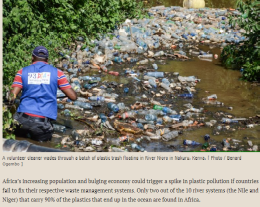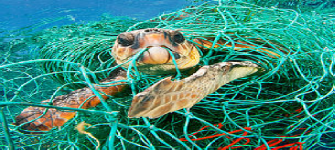
In the first week of COP26, Irene Maithya of Moi University, Kenya takes a timely deeper dive into the relationship between plastic pollution and the global environmental crisis.
Plastics
What comes to mind when you think about plastic?
You may think about how convenient it is when you pick up your takeout order, your Personal Protective Equipment (PPE) masks during these Covid 19 times, packaging bags, plastic shoes, crates, bottles, floor tiles, household wares and containers. You may consider how cheap it is when you purchase new cleaning products for your home. You may even wonder at the physical properties that make it applicable for so many different uses; from toys to life saving medical equipment.
Plastic Pollution
Unknown to many people, plastic bags are manufactured using crude oil.
During manufacturing, plastic emits considerable amounts of pollution, and the end product is not biodegradable. In other words, it is difficult to produce plastic bags, and nearly impossible to get rid of them. It is estimated that 60 to 100 million barrels of oil are required to manufacture a year’s worth of plastic bags worldwide, and it takes at least 400 years for a bag to biodegrade. Some of these plastics bags are used for less than 10 minutes before disposal. This is the kind of devastation plastic pollution causes to our natural environment – from plastic packaging choking and starving animals to microplastics in our water supply.
To climate change.

The Nexus between plastic pollution and climate change
Plastic starts in the ground as a fossil fuel, mainly oil and gas.
Extracting and refining fossil fuels is one of the most energy-intensive industries, releasing millions of tons of greenhouse gas emissions. Does the term “greenhouse gas” ring a bell? That’s because the inordinate amount of greenhouse gases being released into the environment is the main culprit behind climate change. These gases, like carbon dioxide (CO2), become trapped in our atmosphere and warm the climate, much like a greenhouse. This rapid change in climate is melting glaciers, raising sea levels, and causing ever more extreme storms
Therefore, plastic pollution and climate change are not separate problems. The issues are actually intertwined – and each problem makes the other worse. Manufacturing plastic items adds to greenhouse gas emissions, while extreme weather such as the floods and typhoons associated with a heating planet disperse and worsen plastic pollution in the sea.

Way Forward – Solution
Although the problem is complex, the solution is quite simple – make less plastic. Or make no plastic!
Thankfully, it’s not just up to us. Policymakers can support this transition by embracing ingenious governance strategies; by banning unnecessary and dangerous single-use plastic, halting the development of new extraction sites and refineries, making companies pay for the pollution their products create through Extended Producer Responsibility, and incentivizing innovative product designs through government subsidies, favorable taxes to the manufacturing sector and supporting the non-state actors such as Environmental activists.

A great article with a good articulation on the relationship between the two factors and a suggested solution to the issue.
Just on to support by adding on the importance of policy implementation to help sustain our environment. We have reluctant institutions who are lazy in implementing developed policies.
The established nexus between plastic pollution and climate change is necessary for policy and law makers to come up with laws that conserve the environment. Thank you for the insight.
Very Incisive. I love the inclusion of Masks. Masks are soon growing to be a major plastic polluter. Tones of them are them are disposed off daily and there needs to be found a way of their proper and safe disposal.
I agree, plastics have been made to look like the most convenient tools /items for every household.The effects of plastic on our environment has not been given the attention that is needed and that is why I find this timely and eye opening.
“Environment pollution is not only humanity’s treason to humanity but also a treason to all other living creature”
MEHMET M. ILDAN
Great work Irene.
This is quite enlightening bearing in mind that environment pollution has become a global challenge. I love the way the author brings out the simple remedy to this problem.That being to stop production of plastics.
This is very enlightening bearing in mind that environment pollution has now become a global problem. I Love the way the author brings out the remedy to this challenge. I do agree that although the problem is complex, the solution is quite simple – make less plastic. Or make no plastic!
This an extremely well researched article. The solution is apt. Outlaw and reduce plastic use. Policy makers must wake up!
This is incisive piece!!
Excellent work showing that Plastic Pollution and climate change are inextricably linked.
Combating climate change is our collective responsibility.
the problem is getting out of hand.there is a need to make innovations for alternatives, especially for the packaging in developing countries. Sustainable materials are still not being embraced to date. Why? Because we are looking at our own living needs, foregoing the future generations.
I believe a Stringent Legal,institutional and policy framework against plastic pollution in addition to awareness can change the world.
What have we done to the earth,look what we’ve done!
Plastic pollution is undoubtedly one of the most critical global threats of our time. A great piece indeed!
“Although the problem is complex, the solution is quite simple – make less plastic. Or make no plastic!”
This indeed is the perfect solution to this contemporary problem coz the more plastic we make, the more fossil fuels we need, the more we exacerbate climate change.
Well put Doc.
Elias.
This is very enlightening. As you rightly indicated in this piece, policy an implementation of the policies is key to ending polution and managing (possibly reverse climate change).
But most importantly, individual responsibility is much required.Thank you for sharing.
Impressive!
A remarkable yet well thought out masterpiece. Congratulations Ms. Maithya. Indeed it’s time for the global community to collectively,wake up in protecting environment/ecosystem from devastating effect of both plastic pollution and climate change. Our world’s at the moment is glaring new innovations and imaginations in terms of protecting the environment as one of the generational heritage and a key pillar for the 21st century.
An insightful piece, a difficult balancing act, yet an urgent and pressing issue that need to be solved.
A noble initiative and much applauded..we as youths are in environmental protection in particular solid waste management in eldoret Kenya. Currently we are implementing plastic waste recycling project in partnership with the Kenya youth employment opportunities project. We welcome partnership in this initiative of saving mother nature towards attaining sustainable development goals.
This is a well written piece !
It shows the nexus between plastic pollution and the global environmental crisis by using relatable examples.
Kudos once again
This is a very good article,very very educative.I am doing some research on plastics and am glad I came across this article as it has added value to my research work and project!!.Keep on posting such scholarly articles as they are helpful to anyone who could be trying to gather information about plastics.Thankyou for taking your time to do this kind of work,keep up with the good work,I have been in Kenya but I hope to visit again.
Very Noble initiative to save mother nature. We also engage in environmental protection. In particular solid waste collection in eldoret Kenya. We serve the community by providing the much needed service
Currently we in partnership wth
Kenya youths employment opportunity s project are working on plastic waste recycling project. We would welcome partnership in saving the environment from plastic plastic pollution.
t
Thanks very much for this brilliant write-up. In addition to the plastic menace having an impact on the changing climate, the resultant effect on human has seen livelihoods, food security, access to health care and social support structures being impacted negatively. These climate-sensitive health risks are disproportionately being felt more by the most vulnerable and disadvantaged groups that include women, children, poor communities, displaced persons, older populations, and those with co-morbidities.
The globe is facing a global crisis of monumental proportions & the sad thing is that many are oblivious of that fact. Kudos Irene for your stellar piece. We need to have a deep & sincere conversation because as the situation stands we are in a catch-22….plastic plays a major role in our day to day lives but also has far reaching effects on our environment.
Quite an illuminating & timely piece Irene. The globe is in an escalating plastic crisis………the global plastic pollution raises far reaching concerns which require an urgent response that would involve stakeholders from different levels, both in the public & private sector.
Thoroughly enlightening. Policy makers around the world should read this
Thank you for this insightful piece . Its high time we replace most of the plastic bags with reusable ones and do as much recycling as we can.
A timely and important post analyzing the link between Climate Change and plastics. Transitioning to a clean energy/net-zero future requires a transition into a plastic-free economy.
Good ideas made of creativity ……may u come up with more good start…..kudos Irene🥰
Great content love it
Great content love it💯🤗
This is a great content indeed!!!
Very insightful indeed. It’s upon us all to act_ individually and collectively.
I love how you bring out the link between Plastic Pollution and Climate Change. It’s about time we open our eyes to see that all these are man-created problems that can be resolved if action is taken!
A great eye opener, thank you..and also we can be less depended on the takeaways and cook more at home and Carry the food..we can sensitise everyone around us on the hazards of plastic and be role models as we do so… everyone as an individual can help in this..
Very impressive piece!